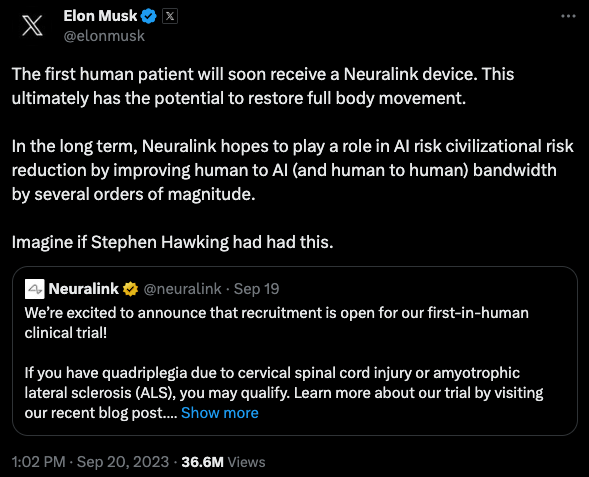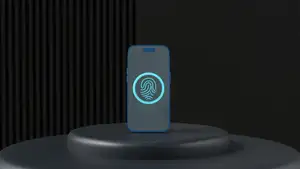
Elon Musk Suggests Having More Bandwidth Between People and Machines: Is That Really Needed?
Tech billionaire and entrepreneur Elon Musk recently suggested that increasing the bandwidth between people and machines was important. It would essentially speed up communication between the brain and devices. However, this is far trickier than it sounds.
Towards the end of September 2023, Elon Musk's post on X (formerly Twitter) essentially said that inserting electrodes directly into a person's head would be the most effective way of increasing the data rate into and out of human brains.

The reason behind the timing of his Tweet (we can still call it Tweet, for the time being, anyway) was to coincide with an announcement made by Neuralink – his BCI (brain-computer interface) company, which is officially searching for the first person to be voluntarily implanted with the N1 chip. This fully implantable, cosmetically invisible tech comprises 1,024 electrodes and is capable of listening to neurons in the human brain - chemicals that transport information between brain cells.
The successful candidate who volunteers for the N1 implantation will be someone with Amyotrophic Lateral Sclerosis (ALS) – a fatal motor neuron disease or has been paralyzed because of an injury to their spinal cord. The experiment aims to let the volunteer use only their thoughts to control external devices, such as controlling a smartphone application or moving a computer cursor. It's not new; similar successful experiments have taken place over several decades, and there's plenty of confidence the experiment will work as planned and bring the results they hope for.
The latest N1 chip has 50% more electrodes than those used in similar Neuralink experiments conducted in the past. Twice as many electrodes means the American neurotechnology company can now gather more data from the volunteers' nerve cells.

This takes us back to Musk's 'Tweet' that suggested increasing bandwidth between people and machines by up to a thousand times or more to speed up communication between the brain and devices. However, is this actually what he was referring to, and could this one day become a reality? Some have compared the tech to resembling telepathy, where someone could say what kind of day they have had in less than a split second.
Musk's post on X discussed several things, one of which was announcing that the first volunteer human patient would soon be implanted with a Neuralink device, and that it could potentially restore full body movement.

This Neuralink project aims to play a crucial part in artificial intelligence civilizational risk reductions by significantly improving the bandwidth between humans and AI (and from humans to humans). He also highlighted what it might have been like if Stephen Hawking could have benefitted from this huge technological development. His post on X was directly responding to an official Neuralink post.
However, the idea of an implantable device in the human brain to increase the rate at which they communicate has been met with increasing criticism and scepticism by scientists. With that in mind, being able to speed up the rate at which computing devices can collect information from the brain is far more realistic. In fact, this method is already the cornerstone used in several state-of-the-art interfaces that can read neurons that transmit information in the human brain. One such example is how many paralyzed people have been able to use cutting-edge devices to communicate.
Concerning this type of technology, the term 'bandwidth' simply refers to the speed at which data is transferred. Many scientists have stated that no matter what language is used, people tend to share information with each other at an average rate of around 40 bits per second, which is described as being relatively slow. In comparison, the speed at which a PC downloads something is around a million times quicker. Reasons for why this is likely never to increase have also been put forward. For example, try listening to more than one person at the same time. Your brain simply can't process it despite your ears allowing the information in. Therefore, the speed at which we think sets our bandwidth limit.
A neuroscientist at Northwestern University in Evanston, Illinois, Lee Miller, who is in the field of brain interface research, recently pointed out the sheer foolishness of the idea that we can improve how people currently communicate by hooking them up with two bits of wire. He's, therefore, not a fan of the idea Musk suggested in his post.
However, some scientists have accepted that there are certain circumstances where a fundamental shift in how people express themselves could be impacted by data being transmitted much quicker. Here is a quick example. Let's just say that you have just been robbed on the street of your personal belongings, and you want to describe, in exact detail, to the police sketch artists what the mugger looked like. In your mind, you can see the face as clear as day. Because most of us can only communicate those details at a rate of 40 bits per second, the entire process of sharing the data like this and getting a result (in this case, the mugger's sketch) can take an extremely long time.

Theoretically speaking, images stored and developed in the mind could be more rapidly transferred between two brains. For example, there is one well-known case of conjoined twins, Tatiana and Krista Hogan, who are capable of sharing parts of the brain. They can see through each other's eyes, meaning they can share information at a rate of 10 million bits a second directly from the retina into the optic nerve. It's just a claim that hasn't been substantiated, but if true, it shows that 'speeding up bandwidth' could be possible and change how we communicate.
Neuralink has also begun investigating whether its pioneering implantable electrodes can work in monkeys to stimulate their visual cortex. Vision generated like this is rather basic, more like a few spots of light, but given time and research and implanting more electrodes, it could potentially be possible at some point in the not-too-distant future, where an image will be shared via a cable between two brains.
A professor at San Diego's University of California, Vikash Gilja, pointed out that Musk tends to think about mental imagery quite a lot and believes that the entrepreneur is merely imagining a time in the future when an image one person might be thinking of would be transmitted to another person via the cortex, or simply presented to that person via a device.
This is where increased bandwidth could be a game-changer, not so much in speeding up how we speak to each other but in how we transfer thoughts via imagery. There may also be a possibility of detecting how someone is feeling by measuring information inside the brain. Someone may find it difficult to describe their feelings, but technological developments could help detect emotional states in previously unimaginable ways.
Matt Angle, the CEO of Paradromics – a Texas-based company that has pioneered its own similar implantable device but with around 1,600 electrodes, thinks that some information that's currently not accessible inside the brain may one day become accessible and decipherable.
Before we get too lost in our imagination, we must focus on the current applications of BCIs (brain-computer interfaces). Is Musk right in saying they need more bandwidth? The sole purpose of these devices is to enable someone who's paralyzed to control a certain device using only their thoughts. Therefore, additional bandwidth isn't essential.
An area where additional electrodes will be beneficial and collecting more information will be useful is to unlock the potential for more natural communication. It has already happened in 2023 when two paralyzed people could communicate with each other via a computer using only their thoughts.
This is possible because the electrodes measure their motor neurons when the two paralyzed people think about what they want to say. Contained inside their thoughts is crucial information about how each person is trying to move their larynx and tongue. Using this kind of crucial data, the technology is capable of understanding exactly what it is the person using the device is trying to communicate, and with incredible accuracy. With additional bandwidth thrown into the mix, plus even more electrodes listening to a greater number of neurons, some leaders in the field are optimistic that the technology will dramatically benefit from this.
Angle also pointed out that concerning speech, we are currently in a system where the rate at which data is transmitted is important, but for cursor control, additional electrodes aren't needed. To make those systems practical, it's obvious that the channel count must be increased. In devices with around a thousand electrodes, it's comparable to a smartphone that transcribes your speech. Therefore, in this particular situation, the information rate is increased by anywhere from around ten to a hundred times.
Conclusion
When it comes to improving how nondisabled people communicate with each other, some have expressed concern that additional bandwidth is important, saying it isn't. The human brain is likely to be the main obstacle. However, when it comes to restoring function in paralyzed people, extra bandwidth will surely make a difference. It currently takes huge amounts of data and many neurons to restore a person's ability to communicate again at the standard rate of 40 bits per second.










